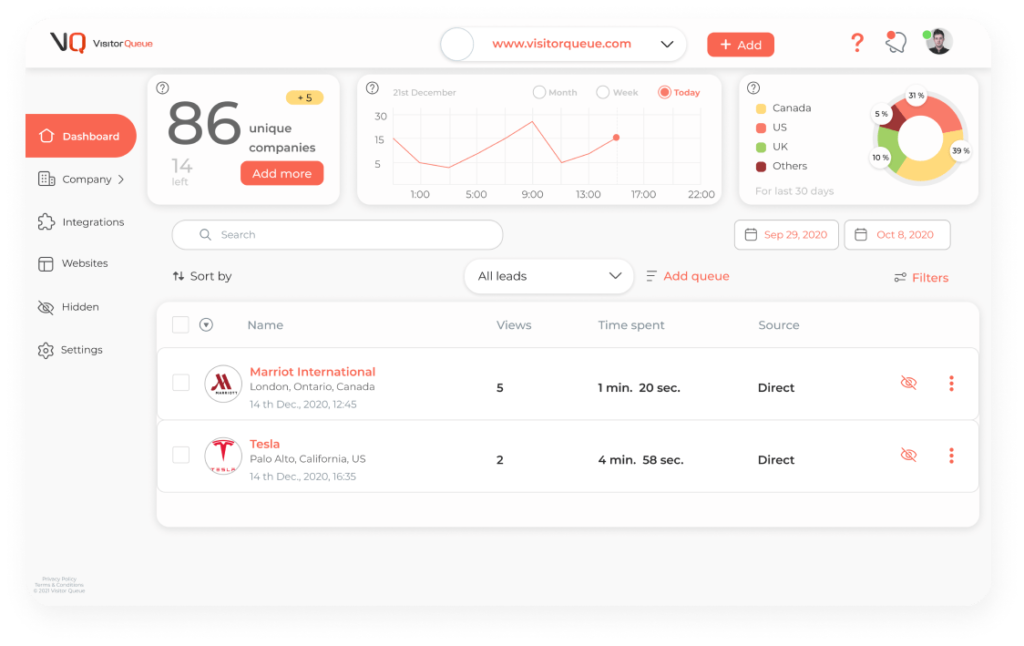We all want to increase our sales. But, we all know how difficult it is to do so. Especially when competition gets tougher on a daily basis. With the help of a strong sales tracking initiative, you can enhance your sales strategies and have a better chance at generating more revenue by knowing exactly what your prospects are doing. Keep reading for the complete guide on sales tracking and increasing revenue.
Sales Tracking Defined
Essentially, sales tracking is the process of monitoring, analyzing, and enhancing your current sales tactics. There are a number of ways to track your sales, including using sales software, measuring sales metrics, and setting goals. Since 65% of prospects end up lost in your sales cycle, it’s extremely beneficial to see where they get lost, and update that step in your sales cycle.
Why is Sales Tracking Important?
Sales tracking is a great way to track the success of your sales efforts. Meticulously tracking means that you can recognize problems early on. As a result, you can solve them before they spiral out of control. In addition, you can see exactly which sales reps are performing the best, and who may need a little guidance. While it’s clear why sales tracking is so important, it can be tricky to get started.

3 Steps to Set Up a Sales Tracking Process
1. Define Success
The first step in setting up sales tracking is to define success. This is because you’ll want a starting point for your tracking. And, it will help narrow down the metrics and software that you track, instead of broadly tracking everything. Think of defining success similar to goal setting. Success can and should look different for each salesperson within your organization. This is because everyone has different skill levels, relationships, and tactics.
2. Talk About It
When you have defined your own success, come together as a team and go over your goals and initiatives. Sharing your ideas and insight can help others optimize their sales strategy, and come up with new ways to track their sales processes. Aside from sharing your thoughts with other salespeople, you can also share with management, marketing, and other teams to help you plan and prepare the best that you possibly can.
3. Refine and Optimize
Unfortunately, not every sales tactic will drive the results you’re looking for. Because of that, when you’re building your sales tracking process, it’s important to refine and optimize your initiatives. In business, if you’re not agile and always changing, you can fall short. When refining and optimizing, try to write down what you’re changing so you can easily refer back to your notes. Again, talking about your updates with others can help you see where you went wrong, or help you come up with even better ways to optimize.
Get Familiar With Your Sales Cycle
Like I mentioned before, on average 65% of prospects end up lost in your sales cycle. This means that they were not properly followed up with, are not engaged, or are not a qualified prospect. By getting very familiar with every step in your sales cycle, you can learn where these leads are getting lost, and try to fix the issues at hand. It can be helpful to talk with your marketing department to get their opinion on your sales cycle and find out what they’re doing to fill your sales funnel. Oftentimes marketing fills the top of a sales funnel, and sales will help guide the most qualified prospects down to convert. So, working as a team can greatly benefit your revenue generation tactics.
Metrics to Measure
As you’ve probably guessed, sales tracking entails a number of different sales metrics. The metrics that you measure will depend on your company, goals, and how you’ve set up your sales tracking process. Here are a few of the most common sales metrics to help you measure your success.
Activity Sales Metrics
Activity sales metrics are some of the easiest metrics to follow, but can help you understand your productivity and sales output. This type of metric refers to actionable tasks. Including how many emails you have sent or replied to, calls made, demos given, and other tasks. These numbers may seem self-explanatory, but a lot of salespeople don’t track them. If you are very familiar with your sales cycle metrics, then you may be able to optimize your activity sales metrics as well. This is because you know exactly how many emails the average prospect needs, when is the perfect time to follow up, and other key points.

Sales Cycle Metrics
Sales cycle metrics also include a number of metrics under one umbrella. A few sales cycle metrics include average length of sales cycle, total opportunities, and number of deals won versus number of deals lost. As you can see, you will have to be very familiar with your sales cycle in order to track each prospect throughout. But, tracking these metrics can help you optimize your sales cycle and even speed up the time it takes for a prospect to go through your cycle.
Customer Lifetime Value
Customer lifetime value, or CLV, tracks the amount that one customer is worth to a business over the course of time they use your product or service. You can calculate this metric by determining how long your average client is with your company, and how much the average client spends per month. So, if the average client stays with your company for 5 years, spending $50 per month, their CLV is $2,500. This means when you are trying to guide a prospect down your sales funnel, you need to spend under $2,500 on marketing and sales expenses to ensure you’re making money.
Lead to Win Rate
Like the name suggests, lead to win rate compares the number of total leads that you have talked to versus the number of leads that actually convert into paying customers. When tracking this metric, it’s best to choose a specific time period to get a proper percentage. As an example, in the first quarter of the year you may have generated 1,000 leads and converted 100 of those into paying customers. So, your lead to win rate would be 10%. Compare this 10% to the second quarter of the year, and see if you’ve increased your lead to win rate.
Sales Software
In order to gain the most insight possible on your prospects, you’ll want to invest in sales software. There are dozens of great sales software options available on the market. The software that you choose should be based on your company goals, budget, and what integrates with the software that you currently use on a daily basis.
CRM
A customer relationship management software, also known as CRM software, is one of the best ways to help you track your sales. A CRM can help you manage your pipeline, follow up with prospects, and help you turn your prospects into paying customers. A CRM is especially helpful if you’re wanting to track activity sales metrics, like how many emails you are sending. If you’re currently using a CRM, but you’re not sure how to get the most out of it, check out this guide on the top tips for CRM management and optimization. On the other hand, if you’re currently not using a CRM or you’re interested in switching softwares, take a look at this list of the best CRM tools for sales teams.
Visitor Queue
Visitor Queue is a B2B lead generation software that tracks the companies that visit your website. See how the company was acquired, how many pages they viewed, and how much time they spent on each page. Additionally, gain access to their employee contact information like email addresses, phone numbers, and LinkedIn channels. As you can see, Visitor Queue is helpful for lead generation. But, we are also helpful for tracking your prospects. As an example, if you see that one of your prospects visits your help or resource pages, you can reach out to them to ensure they found what they were looking for. This way, your prospects are happy and have no questions moving forward, which means they are more likely to convert.

Slintel
Slintel is a sales intelligence tool that can help your sales team maximize growth. This sales software offers many different ways to gain data and insight on prospective clients. One of their most enticing features is their Chrome Extension, that can pull contact information from almost any website that you visit. Then, it will tell you their pain points, preferences, and needs to help you reach out and frame your pitch. Slintel’s clients report that they spend 35% less time researching prospects, increase their email response rate by three times, and double their win rates. These impressive results are a surefire way to enhance your sales pipeline, track prospects, and drive conversions.
monday
With the help of monday, you are able to gain visibility into your sales pipeline to boost productivity and results. monday is an all-encompassing software that offers everything from sales and CRM to marketing, IT, and project management, and everything in between. In regards to sales, you can use monday to automatically track communications with clients, assign tasks to certain salespeople, and integrate with other sales software that you may be using. monday will also provide you with an instant overview of each deal so you can compare and contrast with other deals and with your teammates. Not to mention, monday offers custom plans to fit your sales cycle.
Final Words
As you can see, there is a lot that goes into sales tracking. From tracking the right metrics, to understanding your sales cycle, using the right sales software, and everything in between. However, once you consistently track and improve your sales tracking initiatives, you can understand your prospects better. And, ultimately you’re more likely to convert more of those prospects into paying customers. As always, if you have any questions about how Visitor Queue can help you enhance your sales strategies, do not hesitate to reach out.
 Identify
Identify Personalize
Personalize Benchmark
Benchmark Agencies
Agencies Integrations
Integrations Case Studies
Case Studies Use Cases
Use Cases Blog
Blog Resources
Resources









